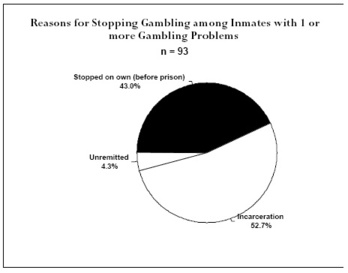Criminal justice populations have higher rates of problem gambling than the general population. Walters* recently interviewed 363 male inmates in a medium security federal prison. This study found that 5.2% of federal inmates were pathological gamblers, while 7.4% were problem gamblers. Subjects who scored greater than 0 on the SOGS were asked if their gambling-related problems had stopped, and if so, how. Respondents chose from the following options: treatment-mediated, self-mediated before coming to prison (either 1 or more years before prison or less than 1 year before prison), incarceration-mediated, and unremitted. While 5.4% of the inmates had sought help for gambling problems, none reported a cessation of problems by means of treatment. The rate of spontaneous remission was inversely proportional to the severity of gambling problems reported by the inmates: inmates scoring > 4 on the SOGS had a spontaneous remission rate of 21%, inmates scoring 3 or 4 had a rate of 44%, and those scoring 1 to 2 had a rate of 60%. The inmates who stopped gambling on their own were older and less often single than those who stopped when they entered prison. These inmates also gambled less frequently, for smaller stakes, and over a shorter period of time than those who stopped upon incarceration. The inmates who stopped gambling on their own were asked about the reasons they stopped. The reasons most often reported for stopping gambling were “tired of or disgusted with losing”, “couldn’t afford to gamble due to new responsibilities”, and “got bored or lost interest”. The author does not distinguish between stopping gambling activity and the cessation of gambling-related problems. Gamblers who stop gambling and their families may continue to suffer from the problems of the gamblers’ history. In addition, it is possible to continue to gamble without experiencing gambling-related problems.
Source: *Walters, G.D. (1997). Problem gambling in a federal prison population: Results from the South Oaks Gambling Screen. Journal of Gambling Studies, 13(1), 7-24.
This public education project is funded, in part, by The Andrews Foundation.





